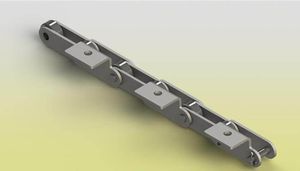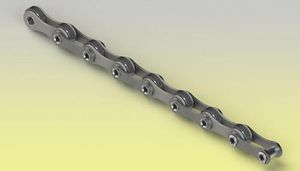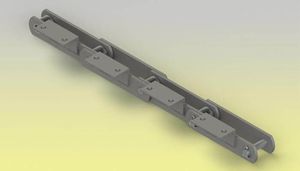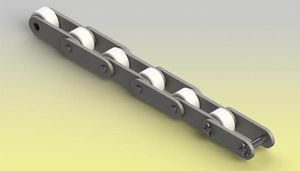
Steel conveyor chain rollerhollow-shaftroller

Add to favorites
Compare this product
Characteristics
- Material
- steel
- Configuration
- roller, hollow-shaft
- Other characteristics
- roller, accumulation, lube-free, for water treatment, needle bearing, roller bearing, for waste treatment, for ovens, for bucket elevators, amusement park, needle cage, for furnaces, for escalators, slaughterhouse
- Width
Max.: 22 mm
(1 in)Min.: 11 mm
(0 in)- Chain pitch
Max.: 150 mm
(5.906 in)Min.: 50 mm
(1.969 in)- Tensile strength
Max.: 75,000 N
Min.: 22,000 N
Description
The standard chains of the ZMC range include products made according to the main international standards (ISO1977, DIN 8165, DIN 8167, DIN 8168, British standard 4119, ANSI / ASME B29.100), and non standard chains of common use.
Versatile and reliable, the standard chains offer the designer a wide choice of solutions for the use of conveyor chains in the various sectors. The range of ZMC standard chains covers a very wide field in terms of dimensions, mechanical characteristics and geometry. They are both metric and imperial chains, with solid, hollow, or extended pins. Standard or deep link plates with attachments are available. In most cases, an alternative with hardened plates is available to increase the breaking load and, on request, in stainless steel or zinc plated finish.
For the sake of identification and research, the traditional ZMC nomenclature is associated with the main series of standard chains:
Z series - Chains with inch pitch according to the English standard BS4119 Part4
M Series - Chains with metric pitch ISO1977, DIN 8167, DIN 8168 standards
Series C - Metric pitch chains according to DIN 8165, internationally known also as FV chains
Catalogs
No catalogs are available for this product.
See all of Z.M.C. SRL‘s catalogsRelated Searches
- Transfer chain
- Metal conveyor chain
- Slatted conveyor chain
- Steel transfer chain
- Link conveyor chain
- Roller transfer chain
- Canning industry conveyor chain
- Attachment conveyor chain
- Stainless steel conveyor chain
- Accumulation conveyor chain
- Conveyor chain for the food industry
- Roller conveyor chain
- Lube-free conveyor chain
- Heavy load conveyor chain
- Hollow-shaft conveyor chain
- Conveyor chain with extended bearing pins
- Double conveyor chain
- Conveyor chain for the automotive industry
- Conveyor chain for the beverage industry
- Bucket elevator conveyor chain
*Prices are pre-tax. They exclude delivery charges and customs duties and do not include additional charges for installation or activation options. Prices are indicative only and may vary by country, with changes to the cost of raw materials and exchange rates.






